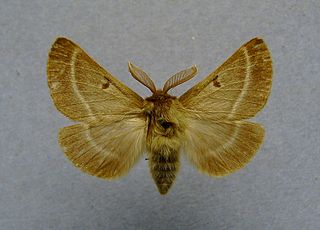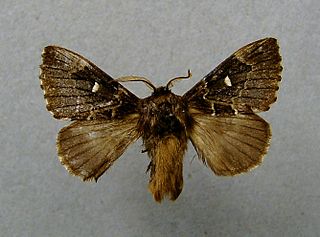
The Drepanidae are a family of moths with about 660 species described worldwide. They are generally divided in three subfamilies) which share the same type of hearing organ. Thyatirinae, previously often placed in their own family, bear a superficial resemblance to Noctuidae. Many species in the drepanid family have a distinctively hook-shaped apex to the fore wing, leading to their common name of hook-tips.

The pine processionary is a moth of the subfamily Thaumetopoeinae in the family Notodontidae, known for the irritating hairs of its caterpillars, their processions, and the economic damage they cause in coniferous forests. The species was first described scientifically by Michael Denis and Ignaz Schiffermüller in 1775, though it was known to the ancients, with remedies described by Theophrastus, Dioscorides and Pliny the Elder. Its processionary behaviour was described in 1916 by the French entomologist Jean-Henri Fabre. It is one of the most destructive species to pines and cedars in Central Asia, North Africa and southern Europe.

The oak processionary is a moth whose caterpillars can be found in oak forests, where they feed on oak leaves, causing significant damage. They travel in nose-to-tail processions, often arrow-headed, with a leader followed by rows of several caterpillars abreast. They are a human irritant because of their venomous setae, which can cause skin irritation and asthma. The species was first described by Carl Linnaeus in his 1758 10th edition of Systema Naturae.

Thaumetopoeinae is a subfamily of moths in the family Notodontidae. This group is sometimes treated as a family Thaumetopoeidae with three subfamilies: Thaumetopoeinae, Anaphinae and Epicominae. However, it is now commonly treated at subfamily rank based on morphological and molecular phylogenetic evidence.

Hyles gallii, the bedstraw hawk-moth or galium sphinx, is a moth of the family Sphingidae. The species was first described by S. A. von Rottemburg in 1775.

Calosoma sycophanta, the forest caterpillar hunter, is a species of ground beetle belonging to the family Carabidae.

The nine-spotted moth or yellow belted burnet is a moth in the family Erebidae. The species was first described by Carl Linnaeus in his 1758 10th edition of Systema Naturae.

Lasiocampa quercus, the Oak Eggar, is a common moth of the family Lasiocampidae found in Europe, including Britain and Ireland. It feeds on a variety of plant species, and may develop over two years in higher latitudes, where it may be known as the Northern eggar. Its suffix quercus refers to the fact that its cocoon generally resembles an acorn, not that its primary food source is oak.
Thaumetopoea bonjeani, the cedar processionary, is a moth in the family Notodontidae. It was first described by Harold Powell in 1922 and it is found in Morocco.

Thaumetopoea solitaria is a moth of the subfamily Thaumetopoeinae in the family Notodontidae first described by Christian Friedrich Freyer in 1838. It is found in Anatolia, on Cyprus, east to Syria, Israel, Lebanon, Iraq and Iran.

Lemonia balcanica is a species of moth of the family Brahmaeidae. It is found in the Balkans.

Cosmotriche lobulina is a moth of the family Lasiocampidae. It is found in Europe through Siberia up to Eastern Asia.

Clostera anachoreta, the scarce chocolate-tip, is a moth of the family Notodontidae. The species was first described by Michael Denis and Ignaz Schiffermüller in 1775. It is found from Europe up to Japan and Korea.

Clostera pigra, the small chocolate-tip, is a moth of the family Notodontidae. The species was first described by Johann Siegfried Hufnagel in 1766. It is a Palearctic species found from Europe ranging to Morocco in the south and eastern Asia in the east.

Xanthandrus comtus is a species of hoverfly. It is found in the Palearctic.

Sterrhinae is a large subfamily of geometer moths with some 3,000 described species, with more than half belonging to the taxonomically difficult, very diverse genera, Idaea and Scopula. This subfamily was described by Edward Meyrick in 1892. They are the most diverse in the tropics with the number of species decreasing with increasing latitude and elevation.

Pyralis manihotalis is a moth of the family Pyralidae described by Achille Guenée in 1854.

Crematogaster scutellaris is a species of ant belonging to the family Formicidae, subfamily Myrmicinae.

Thaumetopoea is a genus of moths belonging to the family Notodontidae. It was first described by Jacob Hübner in 1820.
This page is based on this
Wikipedia article Text is available under the
CC BY-SA 4.0 license; additional terms may apply.
Images, videos and audio are available under their respective licenses.

















